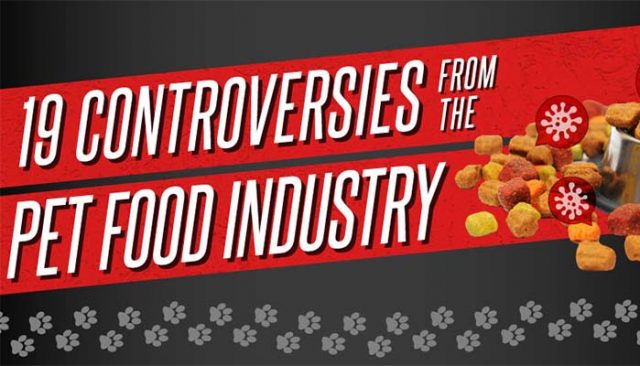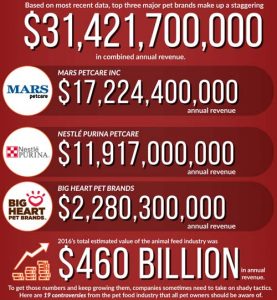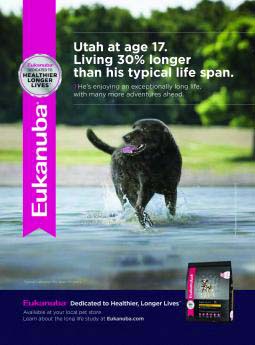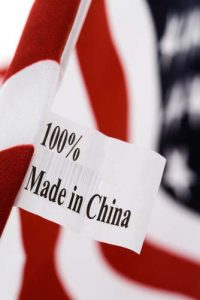
Table of Contents
- 19 Pet Food Industry Controversies
(and why it should matter to all of us)
- 1 Big-name multinationals are buying smaller, natural dog food and cat food companies.
- 2 Pet food multinationals are buying up veterinary care.
- 3 Pet food corporations are trying to silence online critics.
- 4 Pet food multinationals have been accused of price fixing.
- 5 The label on our pets' food isn’t always accurate.
- 6 Settlements don't do much.
- 7 Even when multinationals are found guilty of false advertising, there aren’t any real consequences.
- 8 Pet food grades aren’t consistent.
- 9 “Made in the USA” ads don't always include all the ingredients.
- 10 Little punishment for pet food companies.
- 11 Foul ingredients in pet foods.
- 12 Pet food factory employees are to keep quiet.
- 13 Potential hazards created by pet food factories.
- 14 FDA limits on BPA are inadequate.
- 15 FDA is not strict with pet food recalls.
- 16 The FDA doesn’t consider pet food a high risk for intentional contamination.
- 17 The high temperature of pet food cooking increases cancer risks and decreases nutritional value.
- 18 Fish-based dog foods can be high in mercury.
- 19 Dog food needs careful monitoring of vitamins and minerals, especially high meat formulas.
The last decade hasn’t been easy for pet owners.
There have been so many controversies surrounding the pet food industry that it’s hard to know where to turn. But our buying habits give us power.
When deciding which dog foods or other pet products to get, we’re choosing to support those pet companies.
After I've gone over the last few years of news about the pet food industry, researching the history of lawsuits, pet food recalls, complaints from pet owners, and responses from pet food manufacturers and sellers, this turned into a full-blown list of a staggering 19 controversies from the pet industry.
The thing that most of these controversies have in common is that big multinational companies and outside authorities cannot always be trusted to protect the interests of consumers, i.e., pet owners and their animals.
If you want to choose a truly healthy product for your dog or cat, you can only be more skeptical and educate yourself right now.
Like this infographic? Spread the word! Share it on your site:
<p><strong>Please include attribution to topdogtips.org with this graphic.</strong></p><p><a href="https://topdogtips.org/pet-food-controversies/"><img src="https://topdogtips.org/wp-content/uploads/2017/03/Top-Pet-Food-Controversies-scaled.jpg" alt="19 Pet Food Industry Controversies" border="0" /></a></p>
19 Pet Food Industry Controversies
(and why it should matter to all of us)
The total estimated value of the animal feed industry in 2016 was a staggering $460 billion in annual revenue [1].
With so much cash on the line, it's unsurprising that we're seeing more negative press about certain pet companies and corporations and their cat and dog food products.
1 Big-name multinationals are buying smaller, natural dog food and cat food companies.

The three biggest players in the pet food industry are Nestlé, Mars, and Big Heart Pet Brands (J.M. Smucker). What may have started as a candy bar and jam company back in the day are now massive pet product multinationals.
Together, these companies make a staggering $31+ billion in annual revenue [2]:
- Mars Petcare Inc: $17,224,400,000 reported annual revenue
- Nestlé Purina Petcare: $11,917,000,000 reported annual revenue
- Big Heart Pet Brands: $2,280,300,000 reported annual revenue
And these giant companies are gobbling up the smaller, less processed, more natural pet food manufacturers [3].
This means that it becomes much more difficult to keep track of who makes your pet food, where it's made, and what’s in it [4].
It's also difficult to find out where the ingredients in your pet food are sourced from [5].
2 Pet food multinationals are buying up veterinary care.
It's no secret that poorly made pet food is a major cause of obesity and other health problems in dogs and cats, including the deaths of dogs and cats.
But who is buying up veterinary care in the United States? Mars Petcare Inc. owns Banfield Vet Hospital (the biggest veterinary clinic in the US) and Blue Pearl (one of the world's largest veterinary specialty care chains) [6].
As businesses with one goal on the agenda — increasing profits and minimizing costs — other pet food multinationals are following this example, too.
These companies are buying chains of clinics across the country [7].
Treading this path gives them a convenient outlet to sell “prescription” pet food.
And obviously, it's much easier to write “Recommended by Veterinarians” on your packaging when you own the clinics these vets work for.
3 Pet food corporations are trying to silence online critics.
 When consumers and pet advocates take their complaints online, big pet food companies actively try to shut them down and remove all the negative press and reviews.
When consumers and pet advocates take their complaints online, big pet food companies actively try to shut them down and remove all the negative press and reviews.
For example, NBC News reported that Purina contacted online critics and consumers who posted complaints about Beneful dog food on social media.
Nestlé Purina continues to deny liability for any illnesses and deaths in dogs who regularly ate their food. The lawsuit against them was eventually dropped for lack of evidence [8].
It does seem that the lawsuit didn’t stop them from offering pet owners money to sign restrictive confidentiality agreements.
4 Pet food multinationals have been accused of price fixing.
Mars Petcare, Nestlé Purina, Hill’s Pet Nutrition, PetSmart, and Banfield and Blue Pearl pet hospitals have a class action lawsuit against them for price fixing “prescription” pet foods [9].
When it comes to prescription dog foods and cat foods, since such products contain no drugs or ingredients that aren’t in other pet diets, it’s argued they shouldn’t need a prescription. Plaintiffs say their above-market prices aren’t justifiable either.
5 The label on our pets' food isn’t always accurate.
The first place many of us go when judging how healthy dog food or cat food is doesn’t have to be truthful, according to the law and due to evasive labeling requirements which are governed by AAFCO.
Pet food labels don't have to show ingredient changes right away [10].
Unfortunately for pet owners, pet food companies are allowed to use their old labels on pet food packages until they’re all gone and used up, even if they aren’t accurate.
That means it can actually take a year or more for dog food labels to catch up with what's in the bag or can.
The only thing consumers can do is to check a company's website for changes regularly.
READ ALSO: 16 Things You Didn’t Know About Prescription Dog Food
6 Settlements don't do much.
With so much publicity and lawsuits going on, you'd think there would be positive changes in the pet food industry.
However, it appears that even seemingly large settlements with pet food companies over false advertising do very little for pets and their owners [11].
Blue Buffalo is famous for its promise to provide a healthier pet food without chicken by-products, corn, wheat, soy, or artificial preservatives.
However, they had to agree to pay a $32 million settlement after Nestle Purina found out that their promises for healthier dog foods were not all they were cracked up to be.
Not only was there poultry by-product meal in dog food but there were even feathers.
Blue Buffalo passed the buck to their supplier, Wilbur-Ellis, for sending them poultry by-products without their knowledge.
That sounds like a huge price to pay for a mistake, but according to the agreement, customers who bought certain Blue Buffalo products can’t claim more than $200 each.
That’s only if they saved their receipts. Without them, they’ll get no more than $10.
7 Even when multinationals are found guilty of false advertising, there aren’t any real consequences.
The Federal Trade Commission (FTC) caught Mars Petcare red-handed with false advertising.
What happened was Eukanuba dog food ads claimed there was a 10-year study proving a regular diet of their food could extend a dog’s lifespan by 30% or more:

Mars Petcare admitted there wasn’t enough scientific evidence to back up its statements, but there were no fines to the company or refunds for consumers [12].
According to the report, the FTC will only monitor Mars Petcare to see if they make any further unsubstantiated or misleading claims about their pet food products.
They were warned that the company might be fined if they repeated such behavior.
8 Pet food grades aren’t consistent.
How much do you know about the accuracy of pet food grading? It turns out that making claims that a product is “fit for human consumption” is hard to verify.
Some states — one of them being California — stop pet food companies from saying their pet food is “fit for human consumption.”
According to the CA Code of Regulations, Title 17, Article 16, Processed Pet Food Regulations, § 19025:
“(g) The terms “fit for human food,” “fit for human consumption,” or any similar terms are prohibited on the labels or in advertisements of a processed pet food.“
It’s dog food, right?
Claiming humans can eat it must be false advertising unless they actually can, which was accurately pointed out by Mollie of PoisonedPets.com.
That should apply to a pet manufacturer's website, too, but it’s common to see such claims there.
Unfortunately, there isn’t a set definition for such statements.
According to the regulations [13], it should mean they have an Official Establishment number in the USDA database, and you can look them up on the USDA website, but that’s almost never the case.
9 “Made in the USA” ads don't always include all the ingredients.
 “Made in the USA” has become a big selling point in the pet food industry lately, but some pet food companies are being sued for hiding the source of their ingredients [14].
“Made in the USA” has become a big selling point in the pet food industry lately, but some pet food companies are being sued for hiding the source of their ingredients [14].
The problem is that the FTC says such pet food products should contain negligible foreign content, but there isn’t absolute agreement about what that means.
Pet food manufacturers often rely on cheap vitamin and mineral premixes from China or with Chinese components.
Apparently, they don’t consider these ingredients to be essential enough to make their advertising a lie.
10 Little punishment for pet food companies.
Despite thousands of complaints from consumers, veterinarians, and even FDA reports confirming toxic substances, pet food manufacturers are almost never punished.
There were literally thousands of consumer complaints about Beneful dog food causing illness and sometimes death.
Nestlé Purina PetCare, however, escaped from litigation multiple times because of a lack of evidence [15].
After tons of lawsuits, Blue Buffalo gets off with just warnings or mild fines that won't make a dent in their revenue.
There were even confirmed FDA reports that there were definitely pesticides, mold, arsenic, and lead in dog food of some companies, but the products were never recalled.
Why? That’s because FDA limits are not based on long-term exposure, even though pets commonly eat the same food every day.
And as with the recent Evanger's dog food scandal, the companies and governing bodies continue to place blame on each other with no positive outcome, while it's the pet owners and their animals that suffer from trusting both the companies and the agencies.
11 Foul ingredients in pet foods.
Not many pet owners know that American animal feed and pet food products are intimately connected to the rendering of offal, outdated meat, and “fallen” animals.
The National Renderers Association (NRA) is in charge of processing raw materials that can include animal waste, outdated meat, and fallen animals that are not legally slaughtered.
They partner with the American Feed Industry Association (AFIA) to audit how pet food is made.
Under FSC36, the Safe Feed/Safe Food certification rules [16], and the NRA’s Rendering Code of Practice, ingredients that would normally be judged as filthy, putrid, or decomposed are considered “safe, wholesome, and useful feed ingredients for animals.”
The NRA’s own documents say that the decomposition of meat ingredients “is not always a negative for product quality and food safety” because the bad meat is cooked at such high temperatures when it is rendered down.
(Of course, such a method of high-temperature cooking may potentially destroy nutritional value as well, but that’s a different discussion for another day.)
That’s why meat by-products meal and chicken by-products are avoided by many pet lovers.
When the kind of meat isn’t named, it might even legally include cats and dogs.
RELATED: 15 Ways to Make Sure Your Dog Gets Enough Good Quality Meat
12 Pet food factory employees are to keep quiet.
Settlements with employees mean that dangerous working conditions at pet food plants never fully come to light and may continue at other plants, endangering workers and pets.
For example, Mars Petcare settled a lawsuit by a number of its former employees who worked for them at the now-closed Missouri-Kansas facility in Jasper County [17].
The lawsuit claimed the company didn’t give employees the right personal protection against dangerous chemicals used within the pet food plant, such as mold and phosphine gas, and that Mars Petcare didn’t monitor toxic levels properly.
According to at least one former employee involved in the lawsuit, fumigated meat was frequently not labeled.
It went directly into pet food, and signatures were then forged, saying the ingredients were safe.
A Center For Disease Control and Prevention (CDC) NIOSH report in 2012 said there was so much mold in the factory’s air it couldn’t even be measured by their instruments [18].
That was the case for a number of days.
Diacetyl and 2,3-pentanedione were also found in pet food ingredients.
The plant was closed, however, before it could be investigated further, but no pet foods or other products were ever recalled.
13 Potential hazards created by pet food factories.
It's been reported that pet food factories create “really obnoxious” and potentially dangerous smells that may negatively impact human health.
Dennis Egan is a lawyer with the Popham Law Firm, who led the lawsuit against Mars Petcare about the abominable working conditions at their pet food plant in Jasper County [19].
It was reported in the lawsuit that Mars was allegedly responsible for releasing the toxic chemical compound diacetyl.
It even had to be investigated to see if it affected workers at a nearby popcorn manufacturing plant and town residents.
However, they aren’t the only pet food facility that causes horrible and possibly dangerous smells and gases either.
For example, there have been many complaints about the WellPet factory in Mishawaka.
Dale Emmons, a local Common Council member, asked residents to track days with “really obnoxious” air and to report it to the pet food company [20].
14 FDA limits on BPA are inadequate.
Concerns over Bisphenol A (BPA) safety are becoming more common among consumers, but there’s been little movement to get it out of pet food or even to regulate it.
It’s frequently used to line metal cans and other pet food containers.
There are reports it affects hormone levels and causes other health problems in cats and dogs at high levels and with daily exposure [21].
With more evidence popping up, there is still a lack of safety limits set for the pet food industry and dog food products [22].
15 FDA is not strict with pet food recalls.
Even when the FDA finds undeclared ingredients, drugs, and other chemicals in dog foods that are not on the package label, that doesn’t mean there is a recall or litigation.
Sulfaclozine, an illegal antibiotic, was reported in different jerky dog treats [23].
There was amantadine (a drug that studies have shown has little to no evidence for its efficacy or safety) in 36 percent of dog treats content.
There was even DEET (an ingredient used in insect repellents) in 38 percent of the offending jerky dog treats.
Many consumers reported pet illnesses and deaths, but no products were recalled.
The FDA came to no absolute conclusions or recommendations at the end of their decade-long investigation (PDF).
16 The FDA doesn’t consider pet food a high risk for intentional contamination.
The FDA stated that:
“…animal food is not at a high risk for intentional contamination because our analysis shows that adulteration of animal food has minimal potential for human morbidity and mortality.”
Apparently, pet illnesses and deaths aren’t important considerations as long as it pet foods do not affect people.
This is probably why laws to protect human food from adulteration with rotten meat are not enforced in pet food manufacturing.
17 The high temperature of pet food cooking increases cancer risks and decreases nutritional value.
Dog food, kibble, and even canned foods are usually cooked at such high temperatures carbohydrates form dangerous, cancerous chemical compounds called acrylamides.
This process is called the Maillard reaction.
Many ingredients are cooked and processed before they even arrive at the pet food factory, where they are cooked and processed again, sometimes multiple times.
According to studies, cats can eat up to 38 times more of the cancer-causing compounds than humans [24].
Dogs can get up to 122 times more, and cans are worse for the problem than kibble.
Moreover, further studies have shown that not only does this manufacturing process cause cancer risks, but it also alters and decreases the nutritional value of dog foods [25].
18 Fish-based dog foods can be high in mercury.
In a more recent study of wet and dry cat and dog foods, researchers Adriel Luippold and Mae Sexauer Gustin tested 54 dogs and 47 cat foods, and even when levels were found above that considered safe, the products were not recalled [26].
It’s especially common in pet foods made with fish, although it can be avoided by using specific types of fish.
If not using larger, carnivorous fish higher on the food chain, like salmon and trout, it's possible to avoid high mercury levels in pet foods, according to the authors of the study.
19 Dog food needs careful monitoring of vitamins and minerals, especially high meat formulas.
In 2012, the Petfood Industry reported that “meat-first diets” can easily result in too much of a number of nutrients, minerals, and vitamins, like protein, fat, calcium, phosphorus, and iron, just to name a few.
However, this remains a frequent problem and causes many pet product recalls.
Consumers are looking for more meat when choosing pet food, but it means companies need to check their products carefully and use the safest manufacturing and extrusion methods.
That, of course, drives up prices, as does starting with better-quality ingredients.













